Happy Birthday Governor Knight!
Goodwin Jess Knight, the tap-dancing 31st governor of the 31st state in the union, was born December 9, 1896 in Provo Utah.
The genial moderate Republican, who spoke fluent Spanish, had more in common with his successor, Democrat Pat Brown, than his GOP rival, Cold War ideologue U.S. Sen. William Knowland.
It was Knowland’s presidential ambition and efforts – along with ally Richard Nixon – to control the state Republican Party that led to the end of both Knight and Knowland’s political careers in 1958.
Knight’s father, Jesse, was a lawyer and mining engineer. His mother, Lillie, a concert singer and suffragette.
“Goodie,” as he was called, had his first foray into politics handing out leaflets for Hiram Johnson’s gubernatorial campaign in 1910.
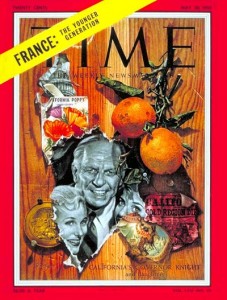 He was drawn to oratory, bribing a janitor $2.50 to let him sneak into an all-woman gathering being addressed by William Jennings Bryan. He attended speeches by Woodrow Wilson, William Howard Taft and Theodore Roosevelt, among others.
He was drawn to oratory, bribing a janitor $2.50 to let him sneak into an all-woman gathering being addressed by William Jennings Bryan. He attended speeches by Woodrow Wilson, William Howard Taft and Theodore Roosevelt, among others.
“Those men had to speak without microphones to huge crowds. They had to have something to say and know what they were talking about. It was a system that eliminated phonies,” Knight said in a lengthy Time magazine cover story appearing May 30, 1955.
As a student at Manual Arts High School in Los Angeles – classmates included Gen. James Doolittle and director Frank Capra – Knight was a yell leader, debating star and, in his junior year, president of the student body.
His class predicted in the yearbook he would be governor – of New York.
Knight’s father’s financial problems prevented him from immediately attending college. He became a miner in Nevada and save enough money to attend Stanford, where he learned tap-dancing and refined his debating talent.
“He was the eternal sophomore,” said Earl “Squire” Behrens, a fellow Stanford graduate and the long-time political reporter for the San Francisco Chronicle.
During summers, Knight shoveled coal for the Santa Fe Railroad and drove delivery trucks.
After a brief stint at Cornell, he passed the California bar in 1921. His law practice with partner Thomas Reynolds grew to be one of the largest – and most lucrative – in the state.
Knight’s backing of GOP Gov. Frank Merriam led to a 1935 appointment to the Los Angeles Superior Court. The pay was $9,000 a year.
A fair share of high profile Hollywood domestic cases came before Knight including the divorce of Barbara Stanwyck and Frank Fay. During his time on the bench he had 14 reversals out of 7,000 decisions.
In a foreshadowing of the decades-later “People’s Court,” he hosted a radio show – “Knight’s Court” – where guests aired their personal problems.
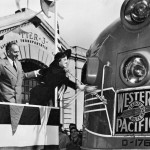
Lt. Gov. Goodwin Knight & Eleanor Parker Christen the California Zephyr 1949
In 1946, Knight left the bench, challenging Democratic San Francisco State Senator Jack Shelly for lieutenant governor.
Knight hired the pioneering public relations and campaign management team of Clem Whitaker and Leone Baxter, who later became husband and wife. Whitaker & Baxter ran every Knight political campaign thereafter.
Knight cross-filed in 1950, winning re-election on both the Democratic and Republican ballots.
When Earl Warren announced he would not seek a fourth term, Knight said he would run to succeed him.
No campaign was needed.
Within a few weeks of Warren’s announcement, Eisenhower nominated him to be Chief Justice of the U.S. Supreme Court.
“The decision of our president, Dwight Eisenhower, and the events of recent days have resulted in my becoming the 31st governor of California,” Knight said in beginning his October 5, 1953 inaugural address.
Unlike the state’s previous chief executives, Knight had experience in all three branches. In those days, the lieutenant governor actually did preside over the Senate.
Reportedly, his performance on the Senate dais was uneven at best, frequently garbling parliamentary rules.
“My parliamentarian says I’m wrong, Time reports him saying. “I overrule myself.”
Knight’s governship was a period of unprecedented population and economic growth that left the state with a $70 million “Rainy Day” fund he worked to preserve.
Knight traveled frequently, logging 84 speeches in his first 59 days as governor, according to Kevin Starr’s Golden Dreams: California in an Age of Abundance, 1950-1963.
Time said he made more than 30 speeches each month – as many as 250 during a campaign.
He was a glad-hander, back-slapper, stemwinder.
Once Knight had to fill 24 minutes at an event at the Hollywood Bowl featuring President Eisenhower. Knight ad-libbed and clowned, entrancing the packed crowd for exactly 24 minutes. As he stepped onstage aftwerwards, Eisenhower groused to his handlers: “This is like sending a batboy in after Babe Ruth.”
If Knight didn’t know a poltician’s name, he bluffed: “I remember the letter you wrote me.”
A favorite joke involved a train as a guard is counting lunatics being taken to an asylum: “One, two, three, four,” the guard recites before spotting Knight.
“Who are you?” asks the guard.
“The next governor of California,” Knight replies.
“Get in line. Five, Six. Seven….”
In his 19 months as governor before the Time interview, Knight had traveled 95,000 miles around the state, usually in his official plane, “The Grizzly,” an aging Douglas C-47, delivering 1,500 speeches.
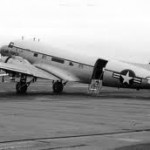
Knight told Time he could think of only three towns in the state he had not visited at one time or another: Tule Lake, Eagleville and Solvang.
“He’d get out of here (Sacramento) at 6:00, perhaps, and get down and make a speech in Los Angeles and come back the same night. He’d get back about 12 or one,” recalled Paul Mason, Knight’s legislative secretary, in a 1980 interview.
“One reason he could do that, he had a capacity to go to sleep any time he was ready to. So he’d get on the plane and he would be asleep before it got off the ground. He’d wake up when he got to the other end of the flight thoroughly refreshed. And he’d also sleep coming back. So he saved two hours of time by sleeping on the plane. [laughter] Besides, when he was asleep he probably couldn’t hear the rattling and the noise of the plane.”
Conservative Republicans hoped Knight would not be as “progressive” as Warren on social issues. Knight disappointed them in part because he viewed his first term as an extension of Warren’s.
If there was doubt in their minds as to his policies, his first inaugural speech should have clarified it.
“It has been the fashion in recent years to label every public servant as a “conservative,” “liberal” and so forth. This kind of political packaging has the advantage of the slogan and, besides, requires little thinking and no research.
“This formula will not be the true test of the coming administration at Sacramento. I shall denounce the rigor mortis of all reactionary policies and shall welcome all workable programs for social betterment.”
He kept some of Warren’s staff but five of his 10 top aides were registered Democrats.
Knight improved care for the mentally ill, boosted unemployment insurance payment and appointed the first woman to the University of California Board of Regents.
Supported by labor — in part because of his background as a miner — Knight pledged to the American Federation of Labor to oppose right-to-work legislation prohibiting union membership or payment of union dues as condition of employment.
He named citizens commissions and convened conferences on issues he wanted to highlight including youth, children and narcotics.
Knight’s first wife, Arvilla, died of a heart attack before be became governor and in the early days of his administration he tended to work late, living at the Hotel Senator while Mrs. Warren moved out of the Governor’s Mansion on H. St.
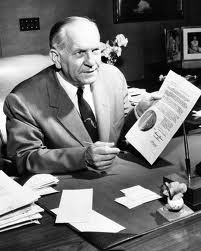
At His Desk
“The governor, at the close of the day quite often, particularly before he was (re)married, would throw his switch on all our squawk boxes and call us for what he called ‘skull practice,’ “ recalled Douglas Barrett who held a number of jobs in Knight’s administration including assistant press secretary.
“We would all come into the inner office and sometimes we would be there into the wee hours of the night. He gave a couple of parties at the Mansion for the staff wives in the interest of domestic harmony.”
Knight was forced to resolve a scandal that developed after a scathing report by the Assembly Committee on Governmental Organization, chaired by San Francisco Republican Caspar Weinberger, found kickbacks being taken by the Board of Equalization’s chair in awarding liquor licenses.
A separate Department of Alcohol and Beverage Control was signed into law by Knight.
Also created by Knight was the Department of Water Resources, which consolidated the multiple state agencies with jurisdiction over water policy.
His push for creation of the department was aided by Weinberger who held a series of around the state in 1954 and 1955 focused on creating a State Water Project that could supply the growing municipal and agricultural demands of the state. Weinberger carried the 1956 legislation creating the department.
Knight continued the state road building efforts, as lieutenant governor he cut the ribbon a stretch of the Hollywood Freeway – but said in his first inaugural speech more rapid transit was needed to combat the “shadowy monster now injuring our health, happiness and recreation” – smog.
He negotiated with the Hearst family over the castle at San Simeon becoming a state park.
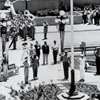
Disneyland Opening Day Ceremony 1955
He attended opening ceremonies at Disneyland in 1955. At the dedication, around the flagpole on Main Street, Knight said:
“And as we dedicate the flag now we do it with the knowledge that we are the fortunate ones to be Americans and that we extend to everyone everywhere the great ideals of Americanism, brotherhood, and peace on earth goodwill towards all men.”
In temperament, Knight was far more avuncular than his more reserved an autocratic predecessor.
In oral histories with several of his staffers housed at the University of California Berkeley Bancroft Library, knight is described as a man who didn’t like being pinned behind his desk and routinely sneaked out of the governor’s office using his private elevator.
On one of his Sacramento sojourns, according to his secretary Sadie Perlin Groves in a 1980 interview, Knight “met a woman who was having trouble with the parking meter. “So the governor said, ‘Well, look, let me try it out.’ He worked with it and he couldn’t get it to work, so he finally put a note on it. It said, ‘To Parking Meter maid. This doesn’t work. [signed] Governor Knight.’
Knight wrote a 100-word testimonial for Grove on what made a good gubernatorial secretary, helping her win Secretary of the Year and a trip to new York City in a contest sponsored by Underwood Typewriter.
What’s required, he said, is a “rare blend of fine qualities…loyalty, integrity and an appreciation of privacy… charm and ability to act promptly with discretion.”
Another frequent stop was a public market, which is presumably, what’s now the Sacramento downtown Sheraton’s foyer that was originally designed by Julia Morgan as a market.
Knight frequented a juice stand there where he often bought sauerkraut shakes, which aided his ulcer. The smell of which, Groves found distasteful.
At the close of business in the governor’s office Knight would stop by and talk to Groves.
“We had carpeting in all the offices but I also had a little platform over the carpet that my chair sat on so I could spin around on it easier, and he’d like to come back there and have a talk and then he’d do a soft shoe. He really, I think, missed his calling. He was just like a very good, old friend come in to visit you and you could discuss anything you wanted with him.”
Peripatetic and popular, Knight, with the help of his new wife, Virginia, and Whitaker & Baxter, coasted to re-election in 1954.
The former Virginia Carlson was a widow whose husband was killed in combat in 1944. They two married in August of 1954, honeymooning on a borrowed yacht off Catalina. Knight had to cut the sojourn short to head to the state GOP convention.
A photograph of Knight carrying her across the threshold of the Governor’s Mansion was widely circulated, enhancing his image.
She became his constant companion and remodeled the mansion’s kitchen as well as collecting memorabilia from previous first ladies believing, prophetically, the structure would eventually become a museum.
Rumors of Eisenhower’s possible retirement made him a presidential contender – no doubt the reason behind the extensive Time interview the following year.
But Knight’s moderate pragmatism and dismissiveness of the Red Scare – “I guess the state is just going to have to get used to the fact that I’m not Joe McCarthy” – put him at odds with increasingly conservative wing of his party.
The leaders of that wing were U.S. Senator William Knowland and then Vice President Richard Nixon.
One of the first visible fights occurred at the 1954 state GOP convention. A Nixon backed candidate challenged Knight’s candidate, Howard Ahmanson, for assistant party chair. Knight won that round.
But by 1956 the rife had deepened. Knight was arguing for Nixon to be dumped from the national ticket. He hoped to add in that effort by using the 70 delegates at his disposal at the Republican National Convention, which was to be held at the Cow Palace.
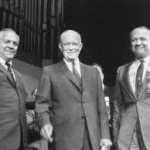
Knight, Eisenhower and Knowland at the 1956 Convention
Knowland, along with Nixon, insisted the delegation be split in thirds – 23 each – with one person selected to represent on behalf of each bloc of 23. The 70th delegate would be U.S. Tom Kuchel.
Nixon and Knowland plotted on hijacking Knight’s part of the delegation at a dinner at the Palace Hotel in San Francisco.
With the help of a Palace employee who was a friend of his wife, an Associated Press reporter disguised himself as a waiter and penetrated the closed meeting. Wearing an apron and holding a tray he began to take notes but was reportedly recognized by Weinberg, who said words to the effect that “A member of the Fourth Estate is here who shouldn’t be.”
The reporter was Joseph J. Lipper, the father of Senate staffer Kip Lipper and public affairs specialist Donna Lucas.
Knowland and Nixon bested Knight at the convention, setting the stage for 1958.
Plotting at a 1960 run for president and believing being a state chief executive a better platform, Knowland declared his candidacy for governor at the Senator Hotel.
Knight was urged by power brokers like Norman Chandler of the Los Angeles Times to step aside and run for Knowland’s vacant Senate seat.
Nixon said one GOP candidate for governor was the best hope for victory.
Claiming illness, Knight retreated to Arizona to recuperate and regroup.
Then he agreed to what’s known as the “Big Switch.”
He declared his candidacy for U.S. Senate – a double-cross from the perspective of the already declared George Christopher of San Francisco and flew to Washington receive Eisenhower – and Nixon’s blessing.
Pat Brown beat Knowland and Clair Engle bested Knight.
It was a change in the state political landscape. Democrats, which already had a 1 million more registered voters than Republicans, now became the dominant party.
Knight returned to Los Angeles. He was television commentator. Opened an insurance company, toyed with a run for governor in 1961 but fell ill and abandoned the idea.
He died of a stroke in 1970, several months after one of his daughters, Carolyn, committed suicide. Widowed again at 51, Virginia never remarried.
“She really was the keeper of the flame,” said a granddaughter, April Aubery, in a 2010 Los Angeles Times obituary. “He was the love of her life. After that, the lights went out. She dropped out of society and became a hermit.”
Knowland died in 1974 of a self-inflicted gunshot wound at his Guerneville vacation home. He had debts totaling $900,000.
Nixon’s subsequent political career is well documented.
-30-
Filed under: California History
- Capitol Cliches (16)
- Conversational Currency (3)
- Great Moments in Capitol History (4)
- News (1,288)
- Budget and Economy (383)
- California History (139)
- Demographics (11)
- Fundraising (74)
- Governor (122)
- Legislature/Legislation (270)
- Politics (173)
- State Agencies (38)
- Opinionation (36)
- Overheard (246)
- Today's Latin Lesson (45)
- Restaurant Raconteur (21)
- Spotlight (110)
- Trip to Tokyo (8)
- Venting (184)
- Warren Buffett (43)
- Welcome (1)
- Words That Aren't Heard in Committee Enough (11)

It was an honor for our family to host Gov. Knight in our home in 1958 for a meet and greet. My sister and I had the fun assignment of welcoming the Governor at the front door. His one staffer was a CHP driver who stayed in the car. The Governor came to the door by himself. He was as warm, friendly, and approachable as you described.
Comment by Bill Leonard — 12.09.2011 @ 7:31 pm
Someone should give Greg a grant for the great info he puts here. Fantastic
Comment by Michael Jarvis — 12.09.2011 @ 11:46 pm